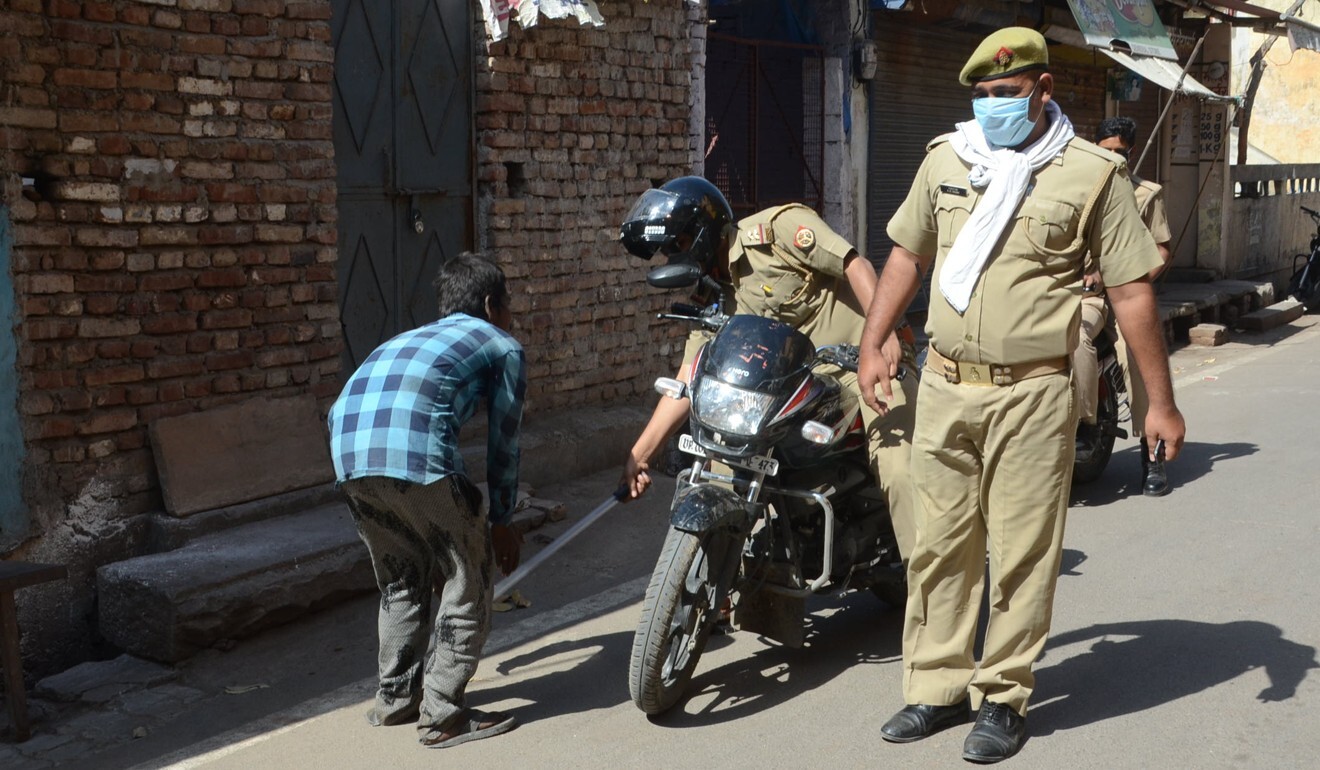
India’s coronavirus lockdown is becoming a humanitarian catastrophe
- India’s three-week lockdown has been devastating for the poor even as they struggle with a potential Covid-19 health crisis
- Informal labourers have been quarantined with no access to food and work, and are facing savage brutality by the police
India’s teeming poor – two-thirds of the population who live on less than US$2 a day – have been the worst affected by the lockdown, which enters its sixth day on Tuesday. They find themselves quarantined with no access to food and face being brutally beaten by the police supported by politically affiliated vigilantes if they dare step out.
Though essential services and grocery shops are permitted to operate during the lockdown, many policemen nationwide have gone on the rampage, threatening shopkeepers and halting the transport of food items if they are not paid the bribes they demand.

Police in Mumbai and many other places also overturned push carts laden with fruit and vegetables, while farm produce rotted in open trucks at places where there were blockades.
Traditionally remitting much of their wages to their families back home, they had little to fall back on when their work was suspended once the lockdown was imposed. They could no longer go to their workplaces as these got locked up, and many were cast out of their meagre accommodation, sometimes along with their families, by landlords who feared rent defaults.
Television viewers and those on social media – the printing of newspapers has been almost entirely suspended – were aghast at scenes of hundreds of thousands of these jobless migrant workers besieging bus terminals waiting for transport to ferry them back home to their families.
As both public and private transport was suspended, many of them were left with little option but to set out on foot, with their belongings strapped to their backs. Some were found to be walking distances as vast as 500km. Many were accompanied by their families and small children and had to dodge police attacks against them en route.
There was one instance where the police made people hop with their heavy rucksacks on a highway as “punishment” for venturing out, and one where an exhausted man broke down when he was offered food after having walked for three days without a meal or any water.
Individuals and religious organisations are providing food at times, in the absence of any help from the government. Often, they have to bribe the police to be able to perform their charity.
Police in the northern state of Bihar shot a truck driver in the foot when he refused to pay a bribe of 5,000 rupees (US$67) to allow his vehicle to transit.
India’s poor, robbed of livelihoods by virus lockdown, flee cities
While some provision stores in towns and cities are managing to trade, though with diminished stock, the situation is grim in the villages – which house nearly 70 per cent of the population – with the police having become a law unto themselves and enforcing a total clampdown.

The current situation has arisen because people were given insufficient opportunity to prepare. Modi gave three days warning before the initial one-day Janata Curfew (People’s Curfew) on March 22, but he declared the three-week lockdown in a televised address at 8pm on March 25, saying it would commence at midnight, within four hours.
94,000 return from virus hotspots to haunt India’s land of migrant workers
The crisis of the poor exacerbates India’s struggle against the coronavirus. The country’s feeble health services are stretched far more than they are in normal times. There are an average 0.55 beds per 1,000 people and one doctor for every 1,457 in India, with these ratios plummeting in rural areas. While the Union Budget for 2020-21 lavished US$43 billion on defence, it allocated only a fifth of that – US$9.2 billion – for public health.
There were 1,071 Covid-19 cases and 29 deaths in India by late on Monday. While these figures are not as menacing as in countries like Italy, Spain, China, Iran or the United States, India is poised to transcend into a community contagion from an individual one if preventive steps are not forthcoming, as the lockdown calls for staying at home, social distancing and personal hygiene.
These are alien concepts in a country with one of the densest populations in the world. India has nearly as many people as China but they are packed into an area a third of its size. The financial capital, Mumbai, is home to 24 million people – the entire population of Australia, which is two and a half times the size of India. On top of that, about a fifth of all urban dwellers in India live in crowded slums, in abject squalor where toilets have to be shared.

